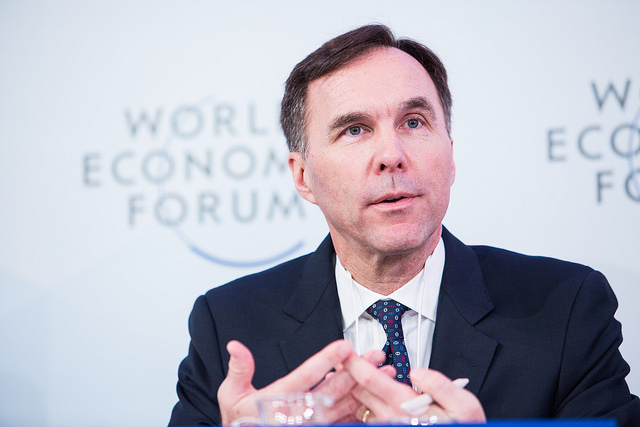
Morneau ducks queries on carbon tax gender costs, but doc says feds have done it
by The Canadian Press

The 2018 budget was billed as the first to undergo a full gender-based analysis, but when asked if a gender-based analysis had been completed for the carbon tax, Finance Minister Bill Morneau side-stepped the question

Finance Minister Bill Morneau says that carbon pricing would be a revenue-neutral measure that will help all Canadians by improving both the environment and the economy. PHOTO: World Economic Forum/Sikarin Thanachaiary
OTTAWA—Finance Minister Bill Morneau isn’t saying whether the federal government has analyzed how its carbon-pricing plan could affect women differently than men—even though documents show it has.
Morneau faced the question from Conservative MP Michelle Rempel during his appearance before the Commons committee on the status of women, where he was pressed to prove his 2018 budget did more than pay lip service to gender equality.
The budget was billed as the first to undergo a full gender-based analysis, which involved examining how every single measure would impact men and women in different ways.
But when Rempel asked Morneau repeatedly if a gender-based analysis had been completed for the carbon tax, he side-stepped the question.
Instead, he repeated his argument that carbon pricing would be a revenue-neutral measure that will help all Canadians by improving both the environment and the economy.
However, a recent order paper question found Environment and Climate Change Canada has indeed put carbon pricing to the gender test—and found the impacts differ, depending on the system and how the revenue is used.
The order paper response, which is similar to an access-to-information request for MPs, said the gender analysis was undertaken in 2016 and later updated in 2017.
“The assessment found that the cost of carbon pricing to households, and how these costs are differentiated by gender, would vary by province and territory, given differences in electricity generation mix … and fuel consumption, and would also depend on the design of each carbon pricing system,” it said.
The document also said a pan-Canadian approach to carbon pricing could have a positive impact by generating revenue that can be used to offset climate change and costs disproportionately felt by vulnerable groups that include women.
The government requires every province to put a price on carbon by the start of 2019 or it will impose one itself.
Four provinces already have carbon pricing systems in place, but Ottawa’s requirement will mean that on Jan. 1, every province will have a regime in place that applies a price of at least $20 per tonne of carbon emissions. The price has to rise $10 per tonne per year until it reaches $50 per tonne in 2022.